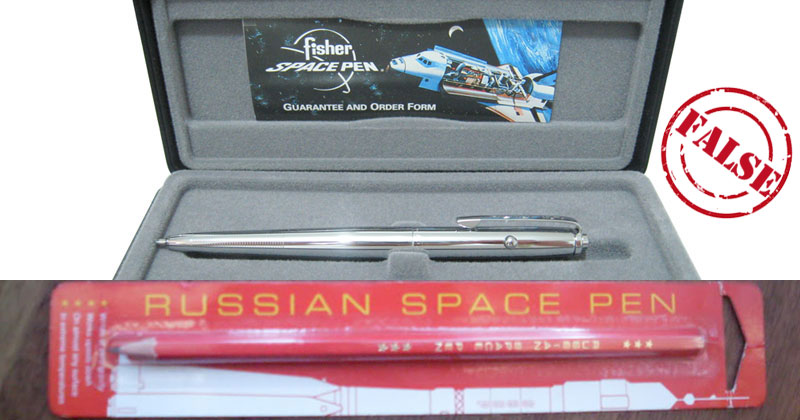Did you hear the one about how the US government spent millions on R&D for a pen that would work in space while the Russians simply used a pencil? The common origin story can even be found on the back of this dollar store ‘Russian space pen’
Even the critically acclaimed show ‘The West Wing’ took the bait on the urban legend:
It’s a fun tale about ingenuity and resourcefulness but lamentably untrue.
During the great Space Race of the 20th century, the United States and Russia in fact both used pencils in space.
The United States opted to use mechanical pencils like the one seen below, used in 1962 by astronaut John Glenn (the buckle attached to his knee to keep it in place!)
While the Russians preferred to use grease pencils like the ones below
Both pencils came with their own set of problems. For mechanical pencils, when the lead broke—as it so often does (even for astronauts!)—it would float around and could either get in someone’s eye or find its way into the machinery, perhaps shorting an electronic device. More concerning was that lead is a flammable material in a high-oxygen environment. (See Apollo 1: Fire)
For grease pencils, it was highly smudgy and imprecise. You also had to peel layers of paper which caused waste. And like its mechanical counterpart it was flammable.
Why not just use a pen?
Because gravity. It’s gravity that forces the ink towards the ballpoint. In space, the ink would just float freely in the cartridge. Take the nearest ballpoint pen and see how long you can write upside down for. It will work for a bit but eventually the ink will run out.
Behold! The $1 Million $1 Billion Space Pen!
Depending on which email chain you receive or which fake news story comes across in your newsfeed, the amount that the US spent researching a pen that would work in space ranged from a million to a billion dollars.
The truth is that the AG7 Fisher Space Pen—which has been used on all manned space flights since it was first used on Apollo 7 in 1968—was funded entirely by engineer and inventor Paul Fisher and his Fisher Pen Company.
During the first NASA missions the astronauts used pencils. For Project Gemini, for example, NASA ordered mechanical pencils in 1965 from Tycam Engineering Manufacturing, Inc., in Houston. The fixed price contract purchased 34 units at a total cost of $4,382.50, or $128.89 per unit. That created something of a controversy at the time, as many people believed it was a frivolous expense. NASA backtracked immediately and equipped the astronauts with less costly items.
During this time period, Paul C. Fisher of the Fisher Pen Co. designed a ballpoint pen that would operate better in the unique environment of space. His new pen, with a pressurized ink cartridge, functioned in a weightless environment, underwater, in other liquids, and in temperature extremes ranging from -50 F to +400 F.
Fisher developed his space pen with no NASA funding. The company reportedly invested about $1 million of its own funds in the effort then patented its product and cornered the market as a result.
Fisher offered the pens to NASA in 1965, but, because of the earlier controversy, the agency was hesitant in its approach. In 1967, after rigorous tests, NASA managers agreed to equip the Apollo astronauts with these pens. Media reports indicate that approximately 400 pens were purchased from Fisher at $6 per unit for Project Apollo (at a 40% discount). The Soviet Union also purchased 100 of the Fisher pens, and 1,000 ink cartridges, in February 1969, for use on its Soyuz space flights. [source]
So there you have it. And I believe Dwayne A. Day of The Space Review said it best:
“The Million Dollar Space Pen Myth is just that, a myth. The pens never cost a lot of money and were not developed by wasteful bureaucrats or overactive NASA engineers. The real story of the Space Pen is less interesting than the myth, but in many ways more inspiring. It is not a story of NASA bureaucrats versus simplistic Russians, but a story of a clever capitalist who built a superior product and conducted some innovative marketing.” [source]
Sources
– Snopes.com: NASA Space Pen
– Mental Floss: The Russians Didn’t Just Use Pencils in Space
– The Space Review: The billion-dollar space pen
– NASA: The Fisher Space Pen
